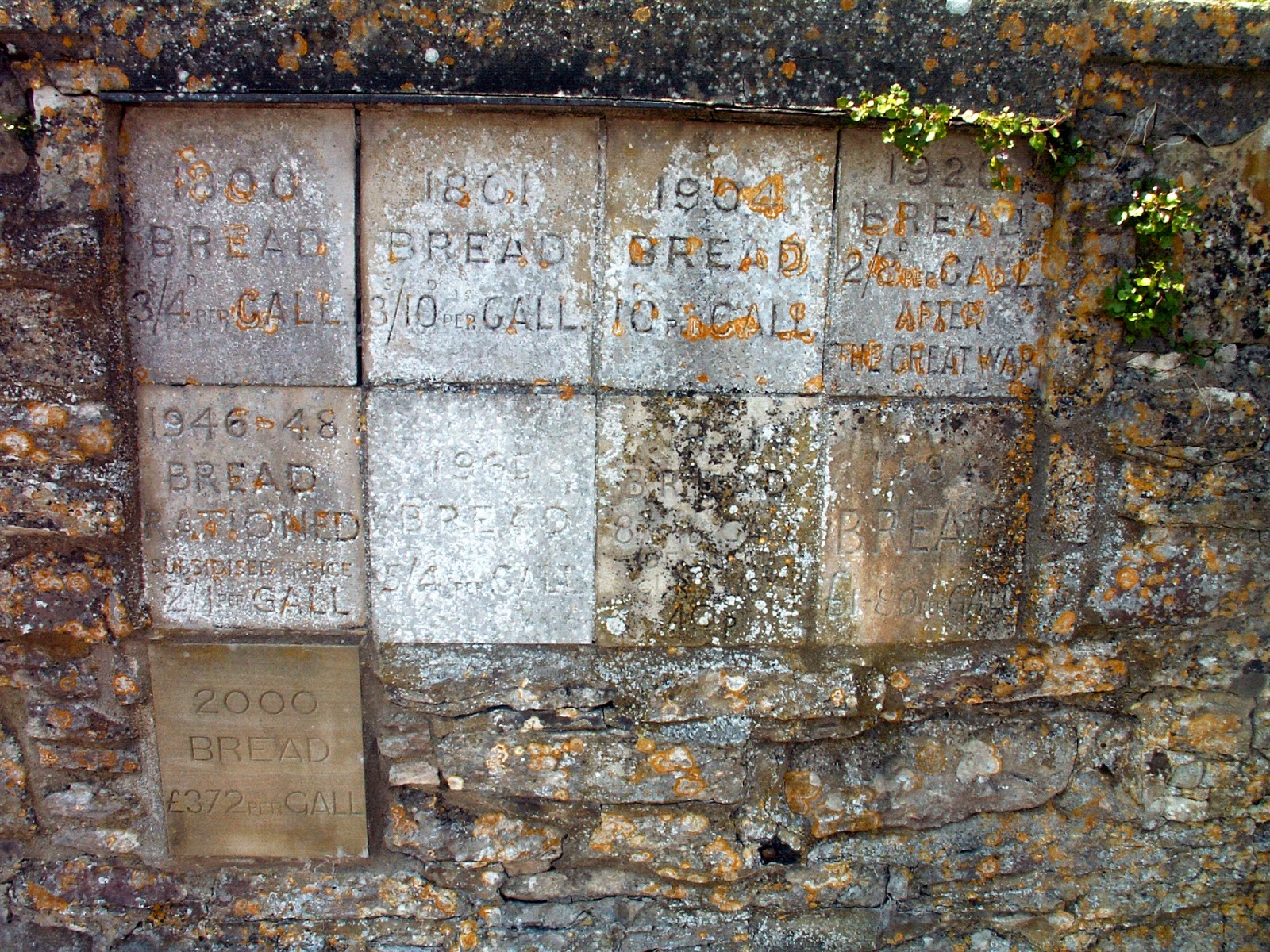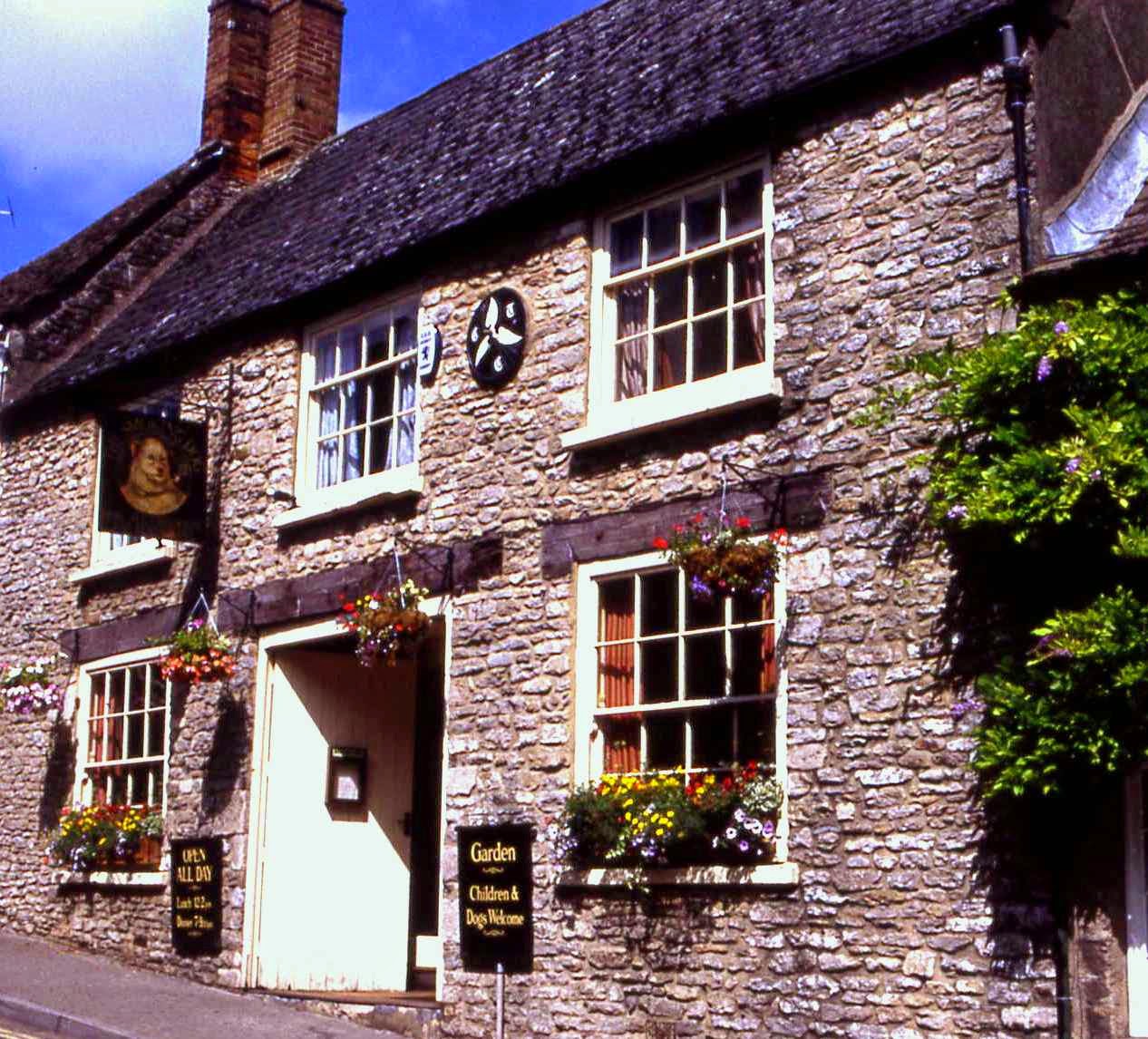In the city centre St Thomas' Church, dating from 1238, has an early 16th century Doom painting showing Christ seated in judgement with
demons seizing the damned
The River Avon flows through Salisbury. A Victorian clock tower beside the bridge in Bridge
Street at the commencement of Fisherton Street, rises above an
unusual plinth .This was the corner of the former gaol and is all that remains
of the building which dated from 1631. This remaining portion with a tiny iron
barred window overlooking the river may have been used as a lock-up following
the demolition of the remainder of the prison.
The village of Great Wishford lies in the delightful Wylye Valley to the north of Salisbury. The prices of bread since 1800 are recorded on the churchyard wall. At one time bread was sold in the semi-fluid state of dough.
Devizes is the a charming market town in the heart of Wiltshire.
Divine retribution may well have
been the result of an incident in the market place at Devizes in
the 18th century. A curious
inscription on the old market cross tells us that :
‘ On Thursday the 25th
January 1753 , Ruth Pierce of Potterne in this county,
agreed with three other women to buy a sack of wheat in the market,
each paying her due proportion
towards the same.
One of these women, in collecting the several quarters of money
discovered a deficiency, and demanded of Ruth Pierce the sum which was wanting
to make good the amount. Ruth Pierce
protested that she had paid her share
and said she might drop dead if
she had not.
She rashly repeated this awful wish, when, to the consternation of the
surrounding multitude, she instantly fell down and expired,
having the money
concealed in her hand.'
Malmesbury Abbey which was founded in the 7th century
Elmer, an 11th century
monk at Malmesbury Abbey, thought he would be able to fly and with
wings fixed to his hands and feet, he launched himself from the abbey
tower. Sadly his initiative was
unsuccessful and he was lamed for life.
He is depicted in a stained glass window at the abbey.
A poignant gravestone in the churchyard is a stark reminder of the days when the Circus came to town, in
this case as far back as 1703.
33 years
old Hannah Twynnoy was a maid at the White Lion Hotel in Malmsbury.
She died on October 23rd, 1703 , after being
savaged by a lion.
The epitaph on her
gravestone reads :
In the bloom of life
She’s snatchd from hence
She had not room
To make defence
For Tyger fierce
Took her life away
And here she lies
In a bed of clay
Until the Resurrection Day.
The curious inn sign at The
Smoking Dog Inn at
Malmesbury depicts a dog smoking a pipe! So what is it all about? Apparently the inn was so named after the
owners of the building found a picture of the smoking dog in the cellar.
Stourton village in the far west of Wiltshire is now part of the Stourhead estate.
Stourhead Park is amongst the finest examples of 18th century landscape gardening in the country.
London banker, Henry Hoare 1, known as the ‘Good’ bought the
old Stourton Estate in 1717, demolished the old manor house and built himself a
fine new house in the Palladian style which he named Stourhead. The family bank and the estate were
subsequently inherited by his son, Henry 11 when he was only 19 years of age
and, inspired by the ‘grand tour’, he commissioned paintings and sculpture to
add to his fine house. True to his name of the ‘Magnificent’ he also turned his
attention to creating a wonderful landscape garden in the steep sided valley
alongside the house when he dammed the River Stour to create a huge lake and
surrounded it with an ever changing vista of mature woodland often referred to
as ‘Paradise’ which indeed it is. His masterpiece however, was to place
neo-classical buildings around the lake depicting the likes of The Pantheon,
The Temple of Apollo, The Temple of Flora and other Gothic ruins and caves,
enhanced by a fine Palladian bridge.
The Pantheon
The Temple of Apollo
Lots of wild life
In 1763, Henry acquired the Bristol High
Cross of 1373 and had it erected on a grassy mound at the head of the lake opposite
Stourton church
of St Peter
The much moved Bristol High Cross was originally erected in 1373 at the
junction of High Street, Broad Street Wine Street Corn Street Bristol
A truncated replica of the cross, made in 1851, stands in Berkley Square , Bristol
Another magnificent building on the estate is
the spectacular red brick folly known as King Alfred’s Tower begun in 1762. The Saxon King fought the Danes with his
small army and won an outstanding victory to maintain England’s freedom. Henry Hoare 11 decided to commemorate the
victory by building the tower on the very spot where he believed Alfred has
raised his standard in AD 878, as well as marking the accession of George 111
to the throne and peace with France valley
of Six
Somewhat overshadowed by the magnificent grounds, the house
itself was designed by Colen Campbell in 1721 and contains a beautiful art
collection and exquisite furniture by a young Thomas Chippendale whilst the
magnificent Regency library is of particular interest. Perhaps the greatest treasure of the house
is the Pope’s Cabinet which has been recently restored to its original
glory. Acquired by Richard Hoare 1 in
the mid 18thcentury, this unusual bejewelled cabinet was built in
the late 16th century for Pope Sixtus V. Thirteen feet tall, it is
made from marble and alabaster in the style of a Roman church and contains 150
secret drawers. The cost of restoration was £50,000 and it has been described as one of the most
remarkable pieces of furniture in Europe with
an estimated value of £8-12m.
There is also a walled garden with glass houses close to the
house and a nearby ice house is of interest.
The estate remained in the Hoare family until 1946 when it was
bequeathed to the National Trust and much of the estate is now managed for
nature conservation.











































No comments:
Post a Comment